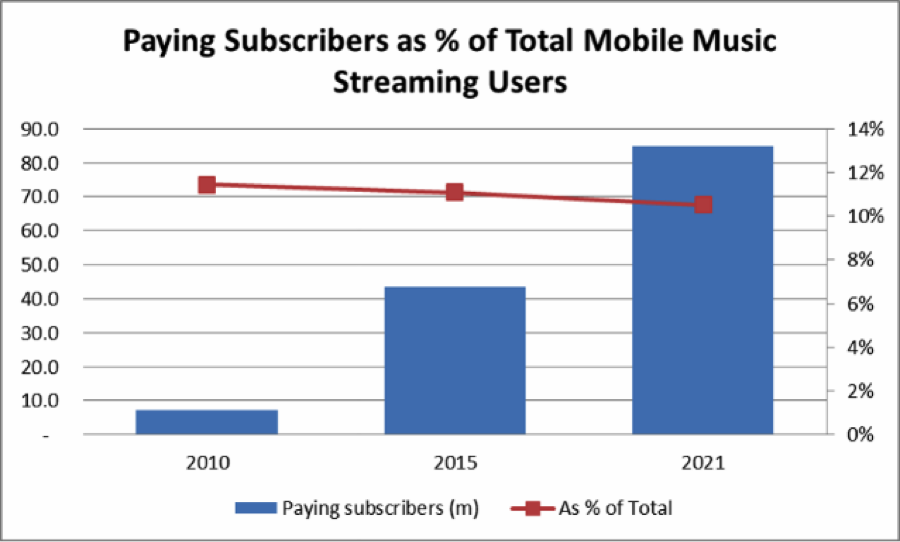On Thursday, XAPP published the Internet Radio Ad Load Report – Holiday 2014. It is the first industry-wide study we are aware of that quantifies the ad serving strategies of leading Internet radio services. The importance of advertising to the future of Internet radio is bound to drive increased attention to factors such as Ad Load practices.
This past fall there were a lot of comments in the media about Internet radio’s two preeminent revenue models: subscription and ad-supported. Recent data from Strategy Analytics and reported by RAIN News suggests that advertising is the present and future of Internet radio listenership. The data concludes that about 89% of Internet Radio listeners today favor the ad-supported option compared to just 11% opting for subscription.
The forecast goes on to predict virtually no change in the ratio in the next six years. In fact, the percent of ad-supported listenership may rise slightly. Many industry participants are partial to the subscription model because of its predictability and its current rate of higher revenue generation per user. However, as the data from the Internet Radio Trends Report 2015 points out, consumers have voted with their ears. Ad-supported listening is, and will be, the primary economic model for Internet radio.
A Tale of Two Models: Pandora and Spotify
Pandora clearly favors the ad-supported model. Based on data from Pandora and Statista, the service maintains about a 5.5% subscriber rate. That is half of the average reported by Strategy Analytics. Advertising revenue at Pandora climbed 40% in 2014 to $732 million. The company is showing how Internet radio can build a strong advertising base and it now accounts for over 9% of consumer radio listening.
By contrast, Spotify is committed to maximizing its subscriber base. The company announced in January that its 15 million subscribers represented 25% of the 60 million monthly active users. Spotify is clear that the ad-supported listening is designed as an on-ramp for consumers to its subscription services tier:
“By bringing listeners into our free, ad-supported tier, we migrate them away from piracy and less monetised platforms and allow them to generate far greater royalties than they were before. Once they are using our free tier, we drive users to our premium subscription tier, at least doubling the amount that they spend on music…”
Making an Ad-Supported Model Work
 Despite all of the focus on subscribers, Spotify maintains a 75% ad-supported user base that can generate hundreds of millions in advertising revenue. There is little doubt that the economics of subscriber revenue are favorable today. However, there is competitive pressure led by Apple to reduce subscription pricing for on-demand music streaming by 20%.
Despite all of the focus on subscribers, Spotify maintains a 75% ad-supported user base that can generate hundreds of millions in advertising revenue. There is little doubt that the economics of subscriber revenue are favorable today. However, there is competitive pressure led by Apple to reduce subscription pricing for on-demand music streaming by 20%.
Downward pressure on subscription revenue rates and the vast majority of listeners preferring ad-supported options mean that a focus must be placed on optimizing ad revenue generation. Internet radio services can increase ad revenue by adopting new ad formats that command higher CPM premiums. As an example, Adweek reported that NPR is receiving “north of $20” CPM using XAPPmedia’s Interactive Audio Ads. That represents a 2-4x premium over existing ad rates. Innovations such as XAPP Ads and a growing user base will continue to make Internet radio ad inventory more valuable.
An Ad-Driven Future
Today, the record labels receive lower royalties when their content is consumed by ad-supported versus subscription listeners. The contracts provide a powerful inducement for them to favor subscriptions over advertising. However, they receive no revenue when their content plays on broadcast radio and would likely sacrifice over 50% of their streaming revenue if ad-supported models were eliminated. At the same time, ad-supported users and advertising revenue are on the rise and there is promise of higher CPMs. All of this can improve the economics for the streaming services, artists and labels.
The ascendance of advertising on Internet radio shouldn’t surprise anyone. Media commentator Greg Satell of Digital Tonto offers this explanation for advertising’s dominance across media that he characterizes as Media’s Golden Rule:
Marketers are willing to pay more for consumers than consumers are willing to pay for content.
Internet radio will continue to be driven by advertising for years to come and that will be a good thing for all parties involved. The challenge for Internet radio providers and streaming services will be to continually increase their ad rates given the competitive constraints on ad load.
Related Posts
WIRED Magazine – Big Winners of 2014: Taylor Swift and Spotify
Taylor Swift vs. Spotify: What Advertisers Need to Know
New York Times Misled by Recording Industry on Internet Radio
Streaming Growth is Not Undermining the Recording Industry

